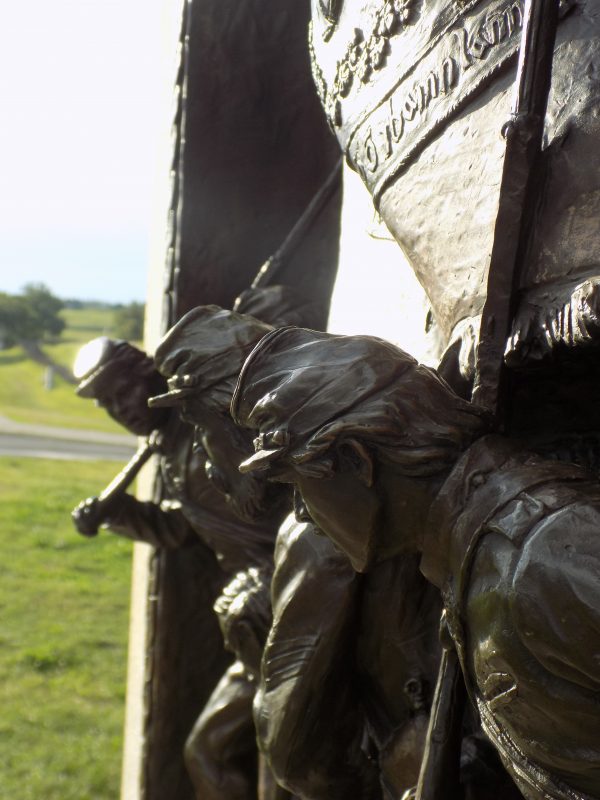Thinking About The Irish Brigade At Antietam

Today is St. Patrick’s Day, a day many folks find something from Ireland to enjoy. I have two traditions on the unofficial holiday: wear a little green and remember the Irish-American contributions during the Civil War. Last year, I wrote about Irish music in America during the 19th Century. This year I find myself remembering Meagher’s Irish Brigade at Antietam. Looking through my photo files and remembering that humidly hot day at the battlefield, I recalled those thoughts and feelings experienced while walking near the brigade’s battle position.
Overwhelmed. The single word to describe my six hour visit to Antietam National Battlefield. There are times we visit battlefields and historic sites for research or armed with a thousand pages of knowledge. There are other times we arrive at hallowed ground with basic knowledge and the desire to wander.
Walking along the trail to the Sunken Road, I watched the storm clouds gathering and momentarily wondered how long the rain would hold off. Maybe the clouds were a hidden blessing because they hastened the departure of other visitors. I wandered through the lonely Sunken Road, taking time to think, remember, and wonder.
Near the observation tower, I turned and saw this monument.

It’s the monument to the Irish Brigade. Comprised of the 29th Massachusetts, 63rd New York, 69th New York, 88th New York Infantry Regiments at Antietam and commanded by General Thomas Francis Meagher, the brigade broke down a rail fence, exchanged volleys, bayonet charged, and advance to within “30 paces” of Confederate General Anderson’s brigade. As the Rebels retreated to shelter in the Sunken Road, the blue-clad Irishmen held position and fired volleys until they used all their ammunition. The brigade lost five hundred forty soldiers at Antietam (dead, wounded, missing.)

The side of the monument facing the open fields pays tribute to the brigade’s organizer and commander at Antietam: General Meagher. An Irish revolutionary banished to Australian colony, Meagher made a daring escape from life-long exile and in 1852 sought refuge on United States soil. He established himself in New York, studying law and working in journalism. His daring escape and life circumstances made him a bit of a celebrity and he toured, giving lectures. Meagher positioned himself as a leader among the Irish-American communities and at the outbreak of the Civil War strongly encouraged his countrymen to volunteer and fight for the country who had given them refugee and opportunity. In his opinion, it was a good opportunity to get military training in case they could later “liberate” Ireland.
Meagher actively recruited Irish-Americans from the beginning of the war and formed “his” Irish Brigade after the First Battle of Bull Run in July 1862. The brigade fought valiantly in the Army of the Potomac at most large battles in the east, often taking risky positions or maneuvers and winning respect from their brother-soldiers. Their distinctive green flags were easily spotted, and the unit gained a fiercely courageous reputation, serving until the original unit disbanded in 1864 from heavy losses.

Many of the soldiers in the Irish Brigade were immigrants. A few were revolutionary exiles. They had arrived in the United States and established Irish-American communities, usually in the large cities. Life wasn’t easy for Irish immigrants and the next generations of Irish-Americans; they faced slander and stereotype judgments from “Know-Nothings” and other nativist groups. Some immigrants saw the Civil War as an opportunity to fight and gain respect from their fellow American neighbors. For some, it became a fight for equality; a fight they took to the battlefield and won through courage and death for a nation that hadn’t always welcomed them with open arms.
A relief in the Irish Brigade monument artistically depicts its soldiers. They “move” as a unit, yet each individual is unique. Leaning forward into the charge toward the enemy, these monument soldiers’ expressions evoke recollection of their past and their embattled future. Many came with families, seeking protection from oppression or famine. Others came alone – fugitives, dreaming of freedoms.
In their disciplined advance and charge at Antietam, the Irish Brigade once again preached a wordless appeal to the watching generals and soldiers on both sides. They silently begged for approval and acceptance as they fought and died for their new homeland. Who could doubt their resolve to be Americans – Irish-Americans – as they exchanged volleys to defend the union?
Fighting a foe, fighting for recognition, fighting for respect. As the green flags rose and the unit pressed forward, they sent a message on that smoky battlefield. Immigrants once. Americans now.

Beautiful photos. Thoughtful words. Thank you for this article.
Reblogged this on seftonblog.
Thanks! Glad you enjoyed it.
The Irish were the first in the fight at the Battle of Bunker Hill leading to the evacuation of Boston By the British, they were instrumental in defeating the Confederacy, the most decorated soldier in WW2 was Audie Murphy, and 58% of the Congressional Metals went to Irishmen .From the inception of the United States the set the standard for Uncommon Valor and Heroism .